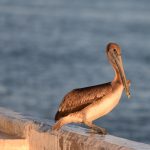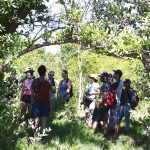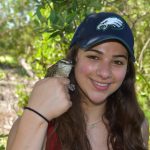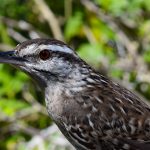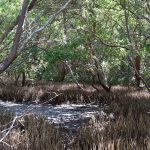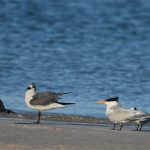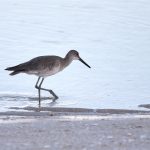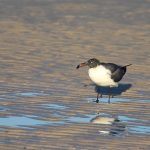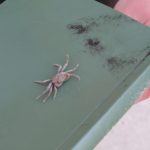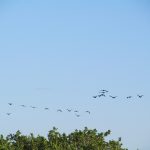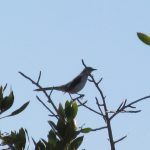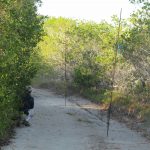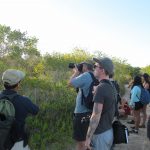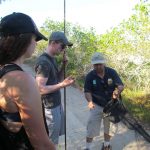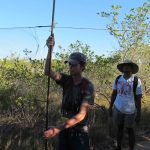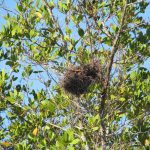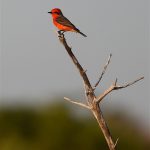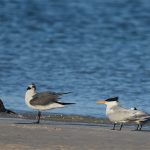After a much-needed night’s sleep (in beds with considerably more lumbar support than our hammocks), we started off our first full day in Celestún. After a short bus ride to near DUMAC (Duck’s Unlimited Mexico Asociación Civil) and extensive sunscreen application, we began our morning adventure in the mangroves beside the Ria Celestún (Celestún Estuary) an area of brackish water with soils with high salt content.
Our first focus of the morning was the bird community that called the vast coastal scrublands and ‘manglares’ their home. After setting up a mistnet and catching two Yucatán Wrens using call playback, our group learned about the unique life history characteristics of this species and even got to watch a blood sample being taken for future genomics research. The wren is an endemic of the Yucatán Peninsula, with a distribution that stretches along the coast from eastern Campeche through the state of Yucatán to Quintana Roo. We continued our trek around the mangroves, and discussed the importance of their presence in coastal regions (serving as ‘nurseries for fish, habitat for innumerable crustaceans, reptiles, mammals, and birds), buffering the coasts from hurricanes, and preventing erosion, as well as their unique physiological and morphological adaptations to an existence in such a stressful – like aerial roots called pneumatophores! We saw evidence of zonation with district stretches of black and red mangroves according to the salinity of the substrate.
When we were done at the mangrove forests, we took a short break before eating lunch at the hotel together. Some of us caught up on school work, some explored the local town, but almost all of us ended up making our way down to the beach for a dip in warm gulf waters and some volleyball on “La Playa”. When we finally filed into the restaurant for lunch, boasting our colourful array of tanlines (or rather varying degrees of redness), we were reminded of why the Bursera trees, with their red peeling bark, were referred to by locals as the “tourist trees”.
After a hearty lunch and a quick hour to settle, the group split into two; while the Mexican students accompanied Jesus, the Canadian students left to return to the mangroves at a different site. This new location boasted shorter trees and fewer mosquitos, and we were glad to stick to the paths to move around. With the experience we gained from the morning’s adventure, our hope was to catch a few more Yucatan wren and observe as many of the other bird species in the area as the afternoon would allow. Spirits were high; within 5 minutes of arriving, we spotted an old wren nest sitting on a tree right next to the path. A little further, we helped Javier and Dr. Lougheed set up a mist-net and watched from afar as Javier used his speaker to project the wren’s call via playback. 20 minutes of occasional fly-by’s and close calls ended with Javier emerging from the bushes, unsuccessful. The wren flying around weren’t getting close enough to the net, probably because they could see Javier lying in wait through the open canopy.
We decided to leave the area to give the wren some space and walked further down the path to try and spot some of the other bird species. According to Javier, there are around 100 different bird species currently living in the mangroves of Celestun. We only saw a handful within the next hour, but we were still pleased with the variety: cormorants, brown pelicans, mockingbirds, hummingbirds, yellow-rumped warblers, and a vermillion fly catcher. A couple small crabs were briefly adopted from the sand as we returned to the empty mist-nets. Enduring another unsuccessful attempt at catching any Yucatan wrens, we packed up, left the mangroves and headed back to our hotel to salsa the night away.
Español
Después de un necesitado descanso durmiendo en camas con mejor soporte de espalda que las hamacas, comenzamos nuestro primer día en Celestún. Después de un viaje corto en el autobús hacia la estación de DUMAC (Ducks Unlimited de México A.C.) y una sesión intensa de ponernos bloqueador solar, iniciamos la mañana aventurándonos en los manglares de la Ría Celestún, un área de aguas salobres y suelo muy salino.
Nuestra atención se centró primero en la diversidad de aves que habitan en el matorral costero y los manglares. Colocamos una red de niebla y poco después capturamos dos individuos de la Matraca Yucateca con el uso de playbacks. Aprendimos de las características únicas de esta especie endémica de la Península, con una distribución que se extiende desde la porción oriental de Campeche, la costa de Yucatán hasta el caribe en Quintana-Roo. Continuamos nuestra expedición en los manglares, discutiendo su importancia en las regiones costeras (su función como sitios de crianza para una gran diversidad de peces, crustáceos, reptiles, aves y mamíferos) frenando el impacto de huracanes y previniendo la erosión, también como su sorprendente adaptación fisiológica y morfológica para sobrevivir en tal ambiente como sus raíces aéreas y los pneumatoforos. Pudimos observar la zonificación con bordes muy marcados entre el mangle negro y rojo determinado por la concentración de salinidad.
Ya que terminamos en los manglares, tuvimos un rato de descanso antes de la comida en el hotel. Algunos aprovechamos para estudiar y avanzar en nuestras tareas, otros fueron a explorar el pueblo, pero la mayoría nos fuimos a la playa para un chapuzón en las cálidas aguas del Golfo y jugar Volleyball de Playa. A la hora de comer, intercambiamos experiencias sobre nuestros variados niveles de rojo y bronceado en la piel. Nos acordamos de por que la Bursera simaruba es llamada el árbol turista por su color rojo y la corteza pelada, similar a cuando se pela la piel después de asolearse.
Después de un nutritivo desayuno y un hora de descanso, nos separamos en dos grupos; el grupo de estudiantes mexicanos se fue con Jesús, mientras los canadienses nos fuimos en busca de otro sitio con manglar. A donde llegamos fue un matorral y manglar con árboles chaparros y menos mosquitos. Nos alegramos de quedarnos sobre un sendero por el cuál exploramos. Con la experiencia adquirida en la aventura de la mañana, esperabamos capturar otros individuos de la matraca yucatéca mientras al mismo tiempo observamos otras aves del área antes de que obscureciera. El ánimo estaba alto; como a los 5min de que llegamos, encontramos un nido Viejo de la matraca justo al borde del camino. Más adelante ayudamos a Javier y al Dr. Lougheed a colocar una red y esperamos a distancia mientras Javier utilizaba una bocina para poner grabaciones y atraer a la especie. Unos 20min de intentar y observar que solo volaban sobre nuestras cabezas, Javier salió de entre el matorral diciendo que no funcionaría porque las matracas podía verlo mientras revoloteaban cerca de él y la red pero sobre el dosel.
Decidimos dejar el sitio de la red para darle oportunidad a las matracas de acercarse; mientras caminamos más lejos sobre el sendero para observar otras aves presentes en el lugar. De acuerdo a Javier, hay unas 100 especies habitando el manglar de Celestún. Vimos solo unas cuantas en el rato que pasamos ahí, pero aún así sorprendidos por la variedad; cormoranes, pelícanos, zenzontles, colibries, chipes y un mosquerito cardenal. Durante la caminata, un par de cangrejos fueron atrapados por los compañeros mientras checabamos la red que estaba vacía. Insistimos en otro intento de captura de las matracas yucatécas con el playback, pero no hubo éxito, así que empacamos y regresamos al hotel para iniciar nuestra noche ya planeada para baile y fiesta.
